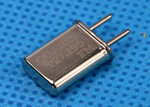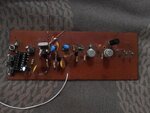Follow along with the video below to see how to install our site as a web app on your home screen.
Note: This feature may not be available in some browsers.

Chinese mark their capacitors oddly.
I think the Chinese schematic says 102P instead of 10 followed by "2" zeros which is 1,000P. They say 103P instead 10,000P.
You should find the schematic from another IC manufacturer or from a toy manufacturer.
Here is another schematic of a 27MHz toy car. It uses 20nF (20,000pF) but your schematic uses 203P (20 followed by "3" zeros) which is also 20,000pF.

You can make the crystal work in any overtone, using a circuit like this.
You must select L and C to tune in the desired frecuency:
F=1/(2*PI*SQRT(L*C))
There is not need to be exact frequency to it work, crystal will do the job. Only select the nearest coil and capacitor to get your desired frequency. If that frequency is a multiple of crystal main frequency it will oscillate.
For your example, choose:
L = 1uHY -> You can buy a inductor with this value
C=1/((48mhz*2*PI)^2 *1uHy ) = 10.99 pf -> Select a fixed 10 pF capacitor
Q1 could be a BC548 (it works up to 300mhz)
I agree with FvM regarding odd/even multiples of the frequency although I can't think of a mechanical reason why it shouldn't be possible. It just seems strange that you have the oscillator running at exactly half the frequency of the crystal.
The only possible explanation if the crystal is correct is that other factors are determining a lower frequency and the crystal is somehow synchronizing on every second 'kick'. Please try something for me: temporarily add a resistor of about 1K in series with the 2.2uH inductor and see what happens. If the inductor and the capacitors around it are tuning to around 13.5MHz it will reduce the 'Q' factor enough to kill most of the resonance.
Brian.
